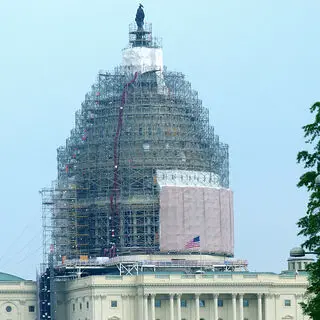
10 Basic Principles for Rehabbing the Right Way
The preservation term rehabilitate can be defined as: "To repair a structure and make it usable again while preserving those portions or features of the property that are historically and culturally significant."
To successfully rehabilitate a historic building, though, it's important to know more than just the definition. While every project will have different needs and solutions, this handy reference guide of 10 basic principles will help you start your rehabilitation project on the right foot.
1. Make every effort to use the building for its original purpose, when possible.
But if you can't, make sure the new use requires minimal change to the original historic features. You might also want to think about ways to recognize, or memorialize, the building's original function (ex. a special plaque, framed historic photographs, or a small informational sign).
2. Do not destroy distinctive original features.
Identify those unique and historic elements that define the building's character, and make every effort to preserve and protect them. Avoid removing or altering elements that are critical to maintaining the original historic fabric of the building.

photo by: takomabibelot /Flickr/CC BY-2.0
When rehabilitating a building, one must preserve the distinctive features that make it unique.
3. Recognize that all buildings are physical products of their own time.
Each one tells a unique story about the people, places, and things surrounding them when they were built. Avoid changes that may create a false sense of historical development.
4. Recognize and respect changes that have taken place over time.
Like a patina acquired over the years, historic properties may change in ways that add to their historic value. Respect and retain those changes that have occurred over time and have gained historic significance in their own right.
5. Sensitively treat and preserve distinctive stylistic features or examples of skilled craft work.
Carefully save and preserve the materials, features, finishes, and examples of craftsmanship that characterize the property.
6. Whenever possible, repair rather than replace worn architectural features.
And when replacement is necessary, new materials should match the old in design, composition, and color. Tip: When constructing a replacement, look for physical evidence in and around the property or research historical documents to find out what the original feature looked like.
7. Clean facades using the gentlest methods possible.
Avoid sandblasting and other damaging methods. Be especially cautious when using chemical or physical treatments, and always test the materials first.

photo by: Jay Galvin/Flickr/CC BY-2.0
It's crucial to respect the changes that have been made to a building over time. This school was enriched by a mural tribute to Cesar Chavez.
8. Protect and preserve archaeological resources.
Keep surrounding archaeological areas intact. However, if an area must be disturbed, take every step necessary to mitigate any harm.
9. Compatible contemporary alterations are acceptable if they do not destroy significant historical or architectural fabric.
When making a significant alteration (like a new addition, exterior alteration, or other new construction), be aware of how it will impact the look and feel of the property. Find a way to differentiate the alteration from the old structure, while using compatible and historically accurate materials as much as possible.
10. Build new additions so they can be removed without impairing the underlying structure.
This way, if they are removed in the future, the essential historic structure will remain intact.
Trying to follow this list to the letter may feel daunting, but doing so will help you rehabilitate a historic property in the most accurate and appropriate way possible. Plus, there are many professionals available to assist you during every phase of your project, from architects and landscapers to researchers and librarians. We also recommend you check in with your local or state historic preservation office for more help.
Donate Today to Help Save the Places Where Our History Happened.
Donate to the National Trust for Historic Preservation today and you'll help preserve places that tell our stories, reflect our culture, and shape our shared American experience.
Bonus: For a more detailed list of recommendations, check out the Secretary of Interior's Standards and Guidelines for Rehabilitating Historic Buildings.
An earlier version of this story was published on February 23, 2016.



%20_%20Paul%20Sableman%20CC%20by%202.0.webp)